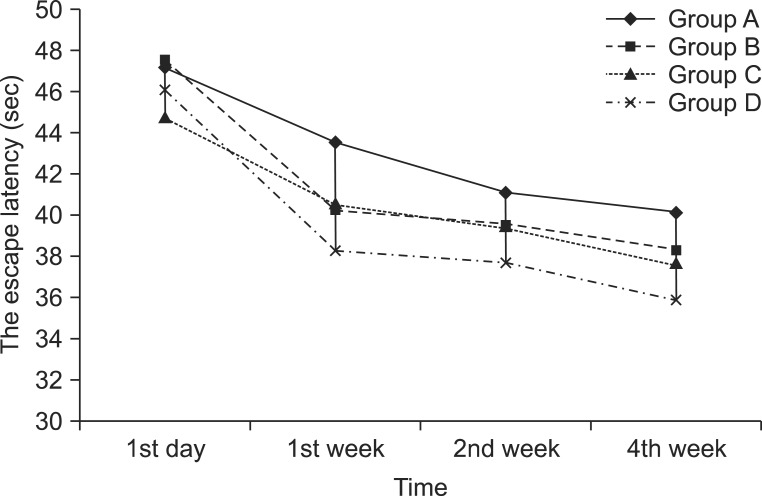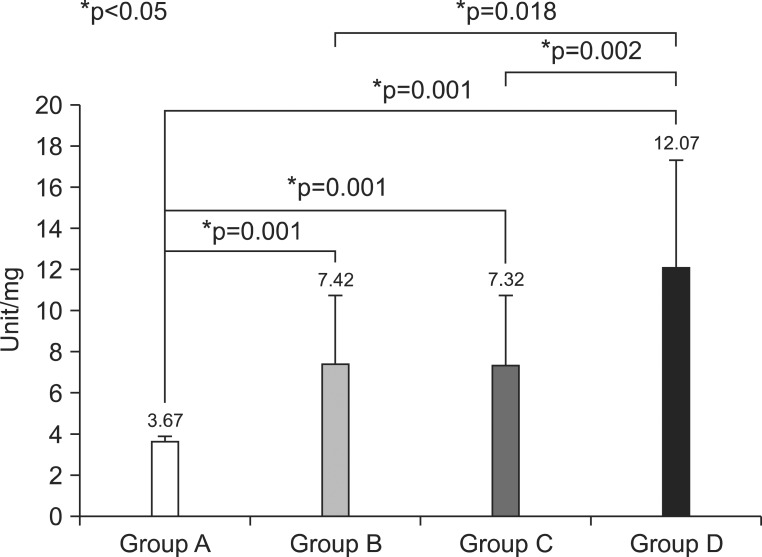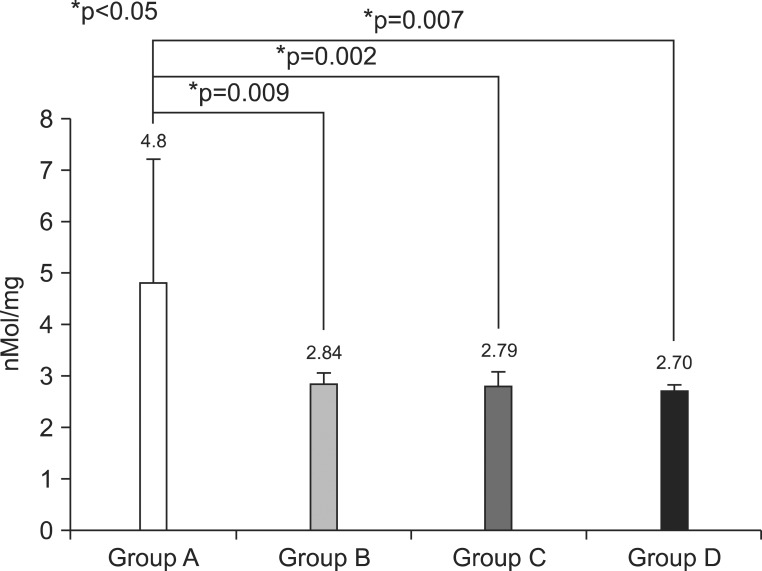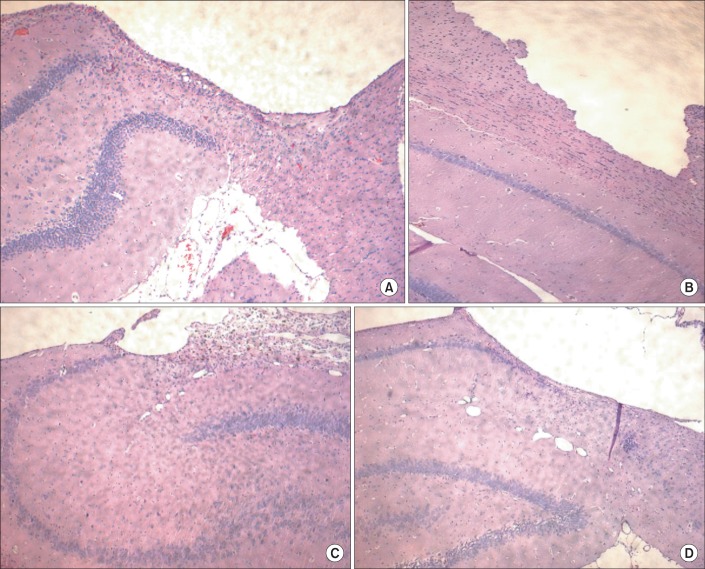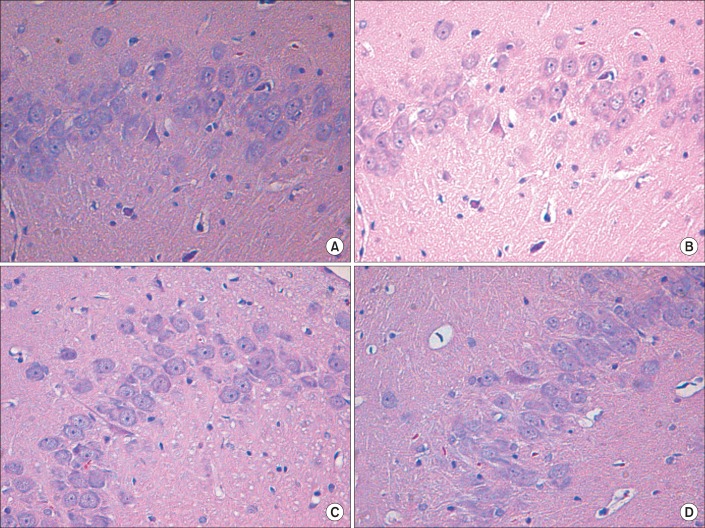Ann Rehabil Med.
2012 Jun;36(3):303-310. 10.5535/arm.2012.36.3.303.
The Effect of Combined Therapy of Exercise and Nootropic Agent on Cognitive Function in Focal Cerebral Infarction Rat Model
- Affiliations
-
- 1Department of Physical & Rehabilitation Medicine, Research Institute of Medical Sciences, Center for Aging and Geriatrics, Regional CardioCerebroVascular Center, Chonnam National University Medical School & Hospital, Gwangju 501-757, Korea. LEE9299@hitel.
- KMID: 2266734
- DOI: http://doi.org/10.5535/arm.2012.36.3.303
Abstract
OBJECTIVE
To investigate the effect of combined therapy of exercise and nootropic agent on cognitive function in a focal cerebral infarction rat model. METHOD: Forty 10-week old male Sprague-Dawley rats were subjected to photothrombotic cerebral infarction of the left parietal lobe. All rats were randomly divided into 4 groups: group A was photothrombotic cerebral infarction rats without any treatment (n=10); group B was photothrombotic cerebral infarction rats with swimming exercise (n=10); group C was photothrombotic cerebral infarction rats with oral administration of acetyl-L-carnitine (n=10); group D was photothrombotic cerebral infarction rats with swimming exercise and oral administration of acetyl-L-carnitine (n=10). Cognitive function was evaluated using the Morris water maze test on the 1st day, and the 1st, 2nd, and 4th week after the induction of cerebral infarction. The activity of superoxide dismutase (SOD) and the level of malondialdehyde (MDA) in the hippocampus were measured. The neuronal cells of the hippocampus were histopathologically evaluated.
RESULTS
The escape latency was shorter in groups B, C, and D than in group A. However, the differences were not statistically significant at the 1st, 2nd and 4th week. The activity of SOD was the highest in group D. The level of MDA was the lowest in group D. We observed more normal neuronal cells in groups B, C, and D.
CONCLUSION
The combined therapy of exercise and nootropic agent was helpful in ameliorating oxidative stress in the focal cerebral infarction rat model. However, the effect did not translate into improvement of cognitive function.
Keyword
MeSH Terms
-
Acetylcarnitine
Administration, Oral
Animals
Cerebral Infarction
Cognition
Hippocampus
Humans
Male
Malondialdehyde
Maze Learning
Neurons
Nootropic Agents
Oxidative Stress
Parietal Lobe
Piracetam
Rats
Rats, Sprague-Dawley
Superoxide Dismutase
Swimming
United Nations
Acetylcarnitine
Malondialdehyde
Maze Learning
Nootropic Agents
Piracetam
Superoxide Dismutase
Figure
Reference
-
1. Moon SK, Shin YI, Kim HI, Lee MC, Jin CY, Lee S, Yoon KH, Cai QY, Chung GH. Chronological changes in cerebral infarction of photochemical thrombosis model: magnetic resonance imaging and histopathological correlation. J Korean Acad Rehabil Med. 2006; 30:447–454.2. Dirnagl U, Iadecola C, Moskowitz MA. Pathobiology of ischaemic stroke: an integrated view. Trends Neurosci. 1999; 22:391–397. PMID: 10441299.
Article3. Balduini W, De Angelis V, Mazzoni E, Cimino M. Simvastatin protects against long-lasting behavioral and morphological consequences of neonatal hypoxic/ischemic brain injury. Stroke. 2001; 32:2185–2191. PMID: 11546915.
Article4. Shake JG, Peck EA, Marban E, Gott VL, Johnston MV, Troncoso JC, Redmond JM, Baumgartner WA. Pharmacologically induced preconditioning with diazoxide: a novel approach to brain protection. Ann Thorac Surg. 2001; 72:1849–1854. PMID: 11789759.5. Zanelli SA, Solenski NJ, Rosenthal RE, Fiskum G. Mechanisms of ischemic neuroprotection by Acetyl-L-carnitine. Ann N Y Acad Sci. 2005; 1053:153–161. PMID: 16179519.
Article6. Acetyl-L-Carnitine. Monograph. Altern Med Rev. 2010; 15:76–83. PMID: 20359271.7. Kidd PM. A review of nutrients and botanicals in the integrative management of cognitive dysfunction. Altern Med Rev. 1999; 4:144–161. PMID: 10383479.8. White HL, Scates PW. Acetyl-L-carnitine as a precursor of acetylcholine. Neurochem Res. 1990; 15:597–601. PMID: 2215852.
Article9. Kiraly MA, Kiraly SJ. The effect of exercise on hippocampal integrity: review on recent research. Int J Psychiatry Med. 2005; 35:75–89. PMID: 15977946.10. Cotman CW, Berchtold NC, Christie LA. Exercise builds brain health: key roles of growth factor cascades and inflammation. Trends Neurosci. 2007; 30:464–472. PMID: 17765329.
Article11. Ang ET, Dawe GS, Wong PT, Moochhala S, Ng YK. Alteration in spatial learning and memory after forced exercise. Brain Res. 2006; 1113:186–193. PMID: 16904660.12. Watson BD, Dietrich WD, Busto R, Wachtel MS, Ginsberg MD. Induction of reproducible brain infarction by photochemically initiated thrombosis. Ann Neurol. 1985; 17:497–504. PMID: 4004172.
Article13. Morris RG, Garrud P, Rawlins JN, O'Keefe J. Place navigation impaired in rats with hippocampal lesions. Nature. 1982; 297:681–683. PMID: 7088155.
Article14. Sun Y, Oberley LW, Li Y. A simple method for clinical assay of superoxide dismutase. Clin Chem. 1988; 34:497–500. PMID: 3349599.
Article15. Draper HH, Hadley M. Malondialdehyde determination as index of lipid peroxidation. Methods Enzymol. 1990; 186:421–431. PMID: 2233309.16. Rogers HJ. Cell death and organ development in plants. Curr Top Dev Biol. 2005; 71:225–261. PMID: 16344107.
Article17. Elinos-Calderón D, Robledo-Arratia Y, Pérez-De La Cruz V, Pedraza-Chaverrí J, Ali SF, Santamaría A. Early nerve ending rescue from oxidative damage and energy failure by L-carnitine as post-treatment in two neurotoxic models in rat: recovery of antioxidant and reductive capacities. Exp Brain Res. 2009; 197:287–296. PMID: 19565224.
Article18. Yin YY, Liu H, Cong XB, Liu Z, Wang Q, Wang JZ, Zhu LQ. Acetyl-L-carnitine attenuates okadaic acid induced tau hyperphosphorylation and spatial memory impairment in rats. J Alzheimers Dis. 2010; 19:735–746. PMID: 20110616.
Article19. Ueno Y, Zhang N, Miyamoto N, Tanaka R, Hattori N, Urabe T. Edaravone attenuates white matter lesions through endothelial protection in a rat chronic hypoperfusion model. Neuroscience. 2009; 162:317–327. PMID: 19409967.
Article20. Balduini W, De Angelis V, Mazzoni E, Cimino M. Simvastatin protects against long-lasting behavioral and morphological consequences of neonatal hypoxic/ischemic brain injury. Stroke. 2001; 32:2185–2191. PMID: 11546915.
Article21. Barhwal K, Hota SK, Jain V, Prasad D, Singh SB, Ilavazhagan G. Acetyl-l-carnitine (ALCAR) prevents hypobaric hypoxia-induced spatial memory impairment through extracellular related kinase-mediated nuclear factor erythroid 2-related factor 2 phosphorylation. Neuroscience. 2009; 161:501–514. PMID: 19318118.
Article22. Barhwal K, Singh SB, Hota SK, Jayalakshmi K, Ilavazhagan G. Acetyl-L-carnitine ameliorates hypobaric hypoxic impairment and spatial memory deficits in rats. Eur J Pharmacol. 2007; 570:97–107. PMID: 17610872.
Article23. Forloni G, Angeretti N, Smiroldo S. Neuroprotective activity of acetyl-L-carnitine: studies in vitro. J Neurosci Res. 1994; 37:92–96. PMID: 7908343.
Article24. Ando S, Tadenuma T, Tanaka Y, Fukui F, Kobayashi S, Ohashi Y, Kawabata T. Enhancement of learning capacity and cholinergic synaptic function by carnitine in aging rats. J Neurosci Res. 2001; 66:266–271. PMID: 11592123.
Article25. Annadurai T, Vigneshwari S, Thirukumaran R, Thomas PA, Geraldine P. Acetyl-L-carnitine prevents carbon tetrachloride-induced oxidative stress in various tissues of Wistar rats. J Physiol Biochem. 2011; 67:519–530. PMID: 21618017.
Article26. Suzuki M, Katamine S, Tatsumi S. Exercise-induced enhancement of lipid peroxide metabolism in tissues and their transference into the brain in rat. J Nutr Sci Vitaminol. 1983; 29:141–151. PMID: 6886836.
Article27. Radak Z, Asano K, Inoue M, Kizaki T, Oh-Ishi S, Ohno H. Acute bout of exercise does not alter the antioxidant enzyme status and lipid peroxidation of rat hippocampus and cerebellum. Pathophysiology. 1995; 2:243–245.
Article28. Davies KJ, Quintanilha AT, Brooks GA, Packer L. Free radicals and tissue damage produced by exercise. Biochem Biophys Res Commun. 1982; 107:1198–1205. PMID: 6291524.
Article29. Radak Z, Kaneko T, Tahara T, Nakamoto H, Ohno H, Sasvari M, Nyakas C, Goto S. The effect of exercise training on oxidative damage of lipids, proteins, and DNA in rats skeletal muscle: evidence for beneficial outcomes. Free Radic Biol Med. 1999; 27:69–74. PMID: 10443921.30. Somani SM, Ravi R, Rybak LP. Effect of exercise training on antioxidant system in brain regions of rat. Pharmacol Biochem Behav. 1995; 50:635–639. PMID: 7617712.31. Radak Z, Kaneko T, Tahara S, Nakamoto H, Pucsok J, Sasvari M, Nyakas C, Goto S. Regular exercise improves cognitive function and decreases oxidative stress in rat brain. Neurochem Int. 2001; 38:17–23. PMID: 10913684.32. van Praag H, Shubert T, Zhao C, Gage FH. Exercise enhances learning and hippocampal neurogenesis in aged mice. J Neurosci. 2005; 25:8680–8685. PMID: 16177036.
Article
- Full Text Links
- Actions
-
Cited
- CITED
-
- Close
- Share
- Similar articles
-
- Cognitive Enhancers in AAMI
- The Effect of U-74389G and MK-801 on the Size of Brain Infarction in the Transient Focal Ischemia-Reperfusion Rat Model
- Influence of Brain Edema on the Antiischemic Effect of D-CPPene in Rat Focal Cerebral Infarction
- A Study of Effect of Recirculation in Experimental Cerebral Ischemia
- The Effects of Exercise-Cognitive Combined Dual-Task Program on Cognitive Function and Depression in Elderly with Mild Cognitive Impairment

